- BOAT OF THE YEAR
- Newsletters
- Sailboat Reviews
- Boating Safety
- Sailing Totem
- Charter Resources
- Destinations
- Galley Recipes
- Living Aboard
- Sails and Rigging
- Maintenance
- Best Marine Electronics & Technology

Pearson 303
- By Bob Reeve
- Updated: April 22, 2008
Pearson303cp368
By the early 1980s, Pearson Yachts of Portsmouth, Rhode Island, had built more than 1,000 Bill Shaw-designed Pearson 30s. To replace that seemingly timeless design, in 1983 Shaw created the Pearson 303, and it’s an entirely different boat. More than 300 were built before production ceased in 1986.
Above the waterline, the Pearson 303’s hull is solid laminate. Balsa core is used in the bottom and in the deck. The rudder is mounted to a substantial skeg, which helps the boat track well downwind.
With its broad beam, the Pearson 303 is quite stiff, and it likes to be sailed on its feet to avoid excessive weather helm. It has a seakindly motion and offers a dry ride and a comfortable, “big boat” feel.
Four adults can occupy the cockpit in comfort. On early models, the mainsheet was at the end of the boom, and with primary winches mounted just forward of the wheel, one person can singlehand with ease. Later boats had midboom sheeting from a traveler on the coachroof. A single-spreader rig supports the keel-stepped mast.
The companionway steps are easily removed to expose the two-piece box surrounding the 13-horsepower Yanmar diesel that will move a P-303 through calm water at 6 knots. Some owners feel it has insufficient power in rough conditions.
The galley, to port just forward of the companionway, is small but adequate. Its best feature, the well-insulated 5-cubic-foot icebox, unfortunately drains to the bilge. Most boats were fitted with a two-burner Origo alcohol stove and a small single sink serviced by both pressure and foot-operated freshwater pumps. A deep bilge sump ensures that the cabin sole stays dry.
Aft to starboard is a large quarter berth. Lockers outboard of it convert readily to a navigation station; later models have a chart table fitted at which the navigator can work while seated at the head of the berth.
Port and starboard settees in the saloon are comfortable berths with the seatbacks removed. A dining table folds down from the starboard bulkhead and has a leaf that extends to the port bench to allow seating for four.
Forward of the saloon and to starboard is the head compartment. Quite large for a 30-foot boat, it has standing headroom, a handheld shower, and an electric pump to drain the sump overboard.
A bifold door opens into a truly comfortable owner’s cabin. It has a small bureau and a large V-berth. Headroom throughout the cabin is more than 6 feet. Large Bomar hatches, above both the forward and main cabins, and four large fixed ports and four opening ports provide plenty of light and air below.
At prices from $30,000 to $35,000 for examples in good condition, the Pearson 303 is an economical and versatile family cruiser from a builder with a reputation for producing solid and reliable boats.
Bob Reeve sails his Pearson 303, Evergreen, from Old Saybrook, Connecticut, with his wife, Susan, and their teenage daughters, Allison and Kristen.
- More: 31 - 40 ft , before 2000 , Coastal Cruising , keelboat , monohull , Pearson , Sailboat Reviews , Sailboats , sailboats classic plastic
- More Sailboats
Sailboat Preview: Dufour 44
New to the fleet: pegasus yachts 50, balance 442 “lasai” set to debut, sailboat review: tartan 455, one mile offshore with christian williams, winds of change, how to protect your spars from corrosion, sailing totem refit series: the forward head makeover.
- Digital Edition
- Customer Service
- Privacy Policy
- Email Newsletters
- Cruising World
- Sailing World
- Salt Water Sportsman
- Sport Fishing
- Wakeboarding
Great choice! Your favorites are temporarily saved for this session. Sign in to save them permanently, access them on any device, and receive relevant alerts.
- Sailboat Guide
Pearson 303
Pearson 303 is a 30 ′ 3 ″ / 9.2 m monohull sailboat designed by William Shaw and built by Pearson Yachts between 1983 and 1986.

Rig and Sails
Auxilary power, accomodations, calculations.
The theoretical maximum speed that a displacement hull can move efficiently through the water is determined by it's waterline length and displacement. It may be unable to reach this speed if the boat is underpowered or heavily loaded, though it may exceed this speed given enough power. Read more.
Classic hull speed formula:
Hull Speed = 1.34 x √LWL
Max Speed/Length ratio = 8.26 ÷ Displacement/Length ratio .311 Hull Speed = Max Speed/Length ratio x √LWL
Sail Area / Displacement Ratio
A measure of the power of the sails relative to the weight of the boat. The higher the number, the higher the performance, but the harder the boat will be to handle. This ratio is a "non-dimensional" value that facilitates comparisons between boats of different types and sizes. Read more.
SA/D = SA ÷ (D ÷ 64) 2/3
- SA : Sail area in square feet, derived by adding the mainsail area to 100% of the foretriangle area (the lateral area above the deck between the mast and the forestay).
- D : Displacement in pounds.
Ballast / Displacement Ratio
A measure of the stability of a boat's hull that suggests how well a monohull will stand up to its sails. The ballast displacement ratio indicates how much of the weight of a boat is placed for maximum stability against capsizing and is an indicator of stiffness and resistance to capsize.
Ballast / Displacement * 100
Displacement / Length Ratio
A measure of the weight of the boat relative to it's length at the waterline. The higher a boat’s D/L ratio, the more easily it will carry a load and the more comfortable its motion will be. The lower a boat's ratio is, the less power it takes to drive the boat to its nominal hull speed or beyond. Read more.
D/L = (D ÷ 2240) ÷ (0.01 x LWL)³
- D: Displacement of the boat in pounds.
- LWL: Waterline length in feet
Comfort Ratio
This ratio assess how quickly and abruptly a boat’s hull reacts to waves in a significant seaway, these being the elements of a boat’s motion most likely to cause seasickness. Read more.
Comfort ratio = D ÷ (.65 x (.7 LWL + .3 LOA) x Beam 1.33 )
- D: Displacement of the boat in pounds
- LOA: Length overall in feet
- Beam: Width of boat at the widest point in feet
Capsize Screening Formula
This formula attempts to indicate whether a given boat might be too wide and light to readily right itself after being overturned in extreme conditions. Read more.
CSV = Beam ÷ ³√(D / 64)
Thanks to ‘Capt Rob’ for providing correction. Dimensions from builders brochure.
Embed this page on your own website by copying and pasting this code.
- About Sailboat Guide
©2024 Sea Time Tech, LLC
This site is protected by reCAPTCHA and the Google Privacy Policy and Terms of Service apply.
Pearson 303
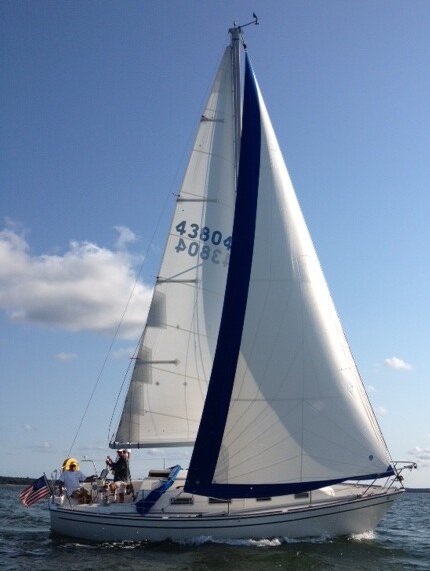
The Pearson 303 is an American sailboat that was designed by William Shaw as a cruiser and built between 1983 and 1986. The company completed more than 300 examples of the design during the four year production run.
The Pearson 303 is a recreational keelboat, built predominantly of fiberglass with a balsa core and with wood trim. It has a masthead sloop rig, a raked stem, a vertical transom, a skeg-mounted rudder controlled by a wheel, with an emergency back-up tiller and a fixed fin keel. It displaces 10,100 lb (4,581 kg) and carries 3,500 lb (1,588 kg) of lead ballast.
The boat has a draft of 4.33 ft (1.32 m) with the standard keel fitted. It has 75 in (190 cm) of headroom, below decks. The boat is fitted with a Japanese Yanmar 3GM(F) diesel engine of 13 hp (10 kW). The fuel tank holds 22 U.S. gallons (83 L; 18 imp gal) and the fresh water tank has a capacity of 38 U.S. gallons (140 L; 32 imp gal).
The boat's galley is located on the port side of the cabin and includes a sink, a two-burner alcohol stove and a 5.0 ft (1.5 m) icebox. Hot and cold running pressure water was a factory option. The cabin sole is made from teak and holly. The head has a privacy door and is located forward, just aft of the bow "V"-berth. Additional sleeping space is provided by the dinette settee, which has a folding table and the aft quarter berth which is a double. The total sleeping accommodation is for six people.
Ventilation is provided by eight opening cabin ports, plus two opening translucent hatches, one in the bow cabin and one in the main cabin. The boat has internal jiffy-reefing. The cockpit has two genoa winches and two winches for the halyards. The mainsheet traveler is mounted on the bridge deck and the genoa has sheet tracks.
Source: Wikipedia . Image Credit: boats.com
LOA: 30.29 ft LWL: 25.37 ft Beam: 10.92 ft Draft: 4.33 ft Displacement: 10100.00 lbs Ballast: 3500.00 lbs Hull type: Fin with rudder on skeg Hull construction: FRP w/balsa core bottom/solid topsides Rigging type: Masthead Sloop
Pearson 303 for sale in the last 12 months
Below you'll find the latest Pearson 303 listings for the last 12 months. We compare the listing price with boats listed in the past and the color coding indicates if the price is good (green = below the average listing price) or more on the expensive side (red = seller is asking more than the average listing price).
Pearson 303 listing prices over time
Listing details.
- New Sailboats
- Sailboats 21-30ft
- Sailboats 31-35ft
- Sailboats 36-40ft
- Sailboats Over 40ft
- Sailboats Under 21feet
- used_sailboats
- Apps and Computer Programs
- Communications
- Fishfinders
- Handheld Electronics
- Plotters MFDS Rradar
- Wind, Speed & Depth Instruments
- Anchoring Mooring
- Running Rigging
- Sails Canvas
- Standing Rigging
- Diesel Engines
- Off Grid Energy
- Cleaning Waxing
- DIY Projects
- Repair, Tools & Materials
- Spare Parts
- Tools & Gadgets
- Cabin Comfort
- Ventilation
- Footwear Apparel
- Foul Weather Gear
- Mailport & PS Advisor
- Inside Practical Sailor Blog
- Activate My Web Access
- Reset Password
- Customer Service

- Free Newsletter

Tartan 30: An Affordable Classic

Ericson 34-2 Finds Sweet Spot

How to Sell Your Boat

Cal 2-46: A Venerable Lapworth Design Brought Up to Date

Solar Panels: Go Rigid If You have the Space…

Leaping Into Lithium

The Importance of Sea State in Weather Planning

Do-it-yourself Electrical System Survey and Inspection

When Should We Retire Dyneema Stays and Running Rigging?

Rethinking MOB Prevention

Top-notch Wind Indicators

The Everlasting Multihull Trampoline

What Your Boat and the Baltimore Super Container Ship May Have…

Check Your Shorepower System for Hidden Dangers

DIY survey of boat solar and wind turbine systems

What’s Involved in Setting Up a Lithium Battery System?

Waste Not is the Rule. But How Do We Get There?

The Scraper-only Approach to Bottom Paint Removal

How to Handle the Head

The Day Sailor’s First-Aid Kit

Choosing and Securing Seat Cushions

Cockpit Drains on Race Boats

Re-sealing the Seams on Waterproof Fabrics

Safer Sailing: Add Leg Loops to Your Harness

Waxing and Polishing Your Boat

Reducing Engine Room Noise

Tricks and Tips to Forming Do-it-yourself Rigging Terminals

Marine Toilet Maintenance Tips

Learning to Live with Plastic Boat Bits
- Sailboat Reviews
A successful design that's good for both club racing and short-term cruising, the 30 is a good investment.
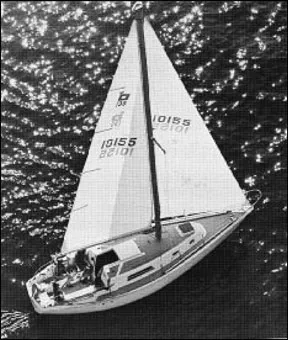
The Bill Shaw-designed Pearson 30 entered production in late 1971. By January 1, 1980, 1,185 of the fin-keel, spade-rudder sloops had been built in the company’s Portsmouth, Rhode Island plant. Peak production years were 1973 and 1974, with about 200 boats produced in each of those years. Production tapered off to about 70 boats per year in the last three years of production, and the P30 was discontinued with the 1981 models, later replaced in the Pearson line by the Pearson 303.
The Pearson 30 was designed as a family cruiser and daysailer with a good turn of speed. The boat is actively raced throughout the country, however, with some holding IOR certificates, and many more racing in PHRF, MORC, and one-design fleets.
The P30’s swept-back fin keel and scimitar-shaped spade rudder are fairly typical of racing boat design from the late 1960s and early 1970s but look somewhat dated next to today’s high aspect ratio fin keels and rudders.
The boat’s underwater shape is somewhat unusual, The hull is basically dinghy-shaped. The sections aft of the keel are deeply veed, however, so that deadrise in the forward and after sections of the boat is similar. Coupled with a fairly narrow beam by today’s standards, this provides a hull form which is easily balanced when the boat is heeled—an important consideration in this relatively tender 30-footer. Above the water the Pearson 30 carries out the standard Pearson credo—moderation in all matters. The hull has a moderate amount of conventional sheer curvature with modest overhangs at bow and stern. The cabin trunk is well proportioned but is of necessity somewhat high to achieve headroom in a small boat without excessive freeboard. Styling is clean and modern with—thankfully—no attempt to incorporate “traditional” detailing. The boat’s appearance may not stir the soul, but neither will it offend the eye.
The Pearson 30 has a well-proportioned masthead rig. The mainsail comprises 44% of the working sail area, more than is found on many modern “racercruisers,” but a reasonable proportion for a true multi-purpose boat.
Base price in 1971 was $11,750. By November 1979, base price had jumped to $28,300. The builder’s option list included about $8,000 worth of goodies for the gadget addict, including wheel steering, a LectraSan toilet system, and a $500 stereo system.
Average 1979 sailaway price was about $35,000. The average 1992 price for that 1979 model is $20-$21,000.
After years of using the Palmer 22 horsepower and 30 horsepower Atomic Four gasoline engines, the late model Pearson 30s came with a two-cylinder Universal diesel, which weighs about the same as the Atomic Four.
Construction
Pearson is one of the oldest fiberglass boatbuilders in the country. Their Triton and Alberg 35 are two of the classic “modern” boats. With over 20 years of fiberglass boatbuilding experience, Pearson has solved most of the construction problems that seem to plague some builders.
The layup schedule of the Pearson 30 did not change during the production life of the boat. The hull structure is a hand layup in a one-piece mold of alternating plies of 1 1/2-ounce mat and 18-ounce woven roving. Two layers of omni-directional mat are used beneath the gelcoat to prevent “print through” of the first roving layer, an unsightly and unfortunately common problem with some builders.
Below the waterline, the Pearson 30 hull is a solid seven-ply layup, yielding an average bottom thickness of .29″. Along the keel, the plies from each side are overlapped, doubling the thickness in this critical area. The topside skin is five plies of mat and roving, with an average thickness of .21″. The deck is a fiberglass/balsa sandwich.
The hull-to-deck joint is made by glassing together the external flanges of the hull and deck. This chemical bond is backed up by stainless steel self-tapping screws at intervals of approximately 4″. The flanges are covered by an extruded plastic rubrail holder, covered by the familiar Pearson soft vinyl rubrail.
One Pearson 30 owner who races his boat reported that the hull-to-deck joint had opened slightly at the bow from excessive headstay tension. No other owner reported this problem, and examination of a large number of Pearson 30s failed to reveal another hull with this problem. Excessive headstay and backstay loading is often found in racing boats and can damage any boat not designed for this type of loading.
The Pearson 30’s spade rudder has provided the only recurrent problem with the boat. The rudder stock consists of a thick-walled stainless steel pipe. The stock enters the hull through a slightly larger diameter fiberglass rudder tube, which projects above the waterline to the cockpit sole, eliminating the need for a stuffing box. The rudder stock rides in two Delrin bushings, one at the top and one at the bottom of the fiberglass rudder tube. Wear in these Delrin bushings causes play to develop in the rudder stock. This wear can be accelerated by failing to tie off the tiller when the boat is at rest, thus letting the stock turn from the natural motion of the boat.
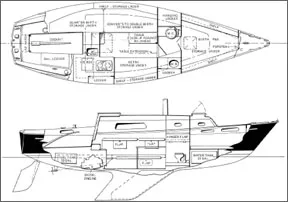
The bushings are owner-replaceable when the boat is hauled out, requiring removal of the tiller fitting and dropping the rudder through the bottom of the boat. The bushings can then be pried out and replaced.
The frequency with which rudder bushings must be replaced varies with the amount of use the boat receives. Pearson considers the bushings an item of routine maintenance. We would recommend that they be replaced whenever any slop develops. About 30% of the boats we examined showed significant bushing wear.
We also found annoying and excessive play in the tiller fitting which might sometimes be confused with bushing wear. Correcting this requires shimming or bushing the cast aluminum tiller socket.
The first Pearson 30s had an aluminum pipe rudder stock rather than stainless. Several rudders broke off as a result of corrosion at the narrow gap between rudder and hull. To Pearson’s credit, the firm recalled and replaced the rudders on the approximately 200 boats built with aluminum stocks. The error in using aluminum stocks was far outweighed by the company’s willingness to correct a potentially serious problem.
The Pearson 30’s 3,560 lbs of lead ballast is encapsulated in the fiberglass keel molding, This avoids the necessity of keel bolts but makes the keel more vulnerable to grounding damage.
The deck-stepped, polyurethane-painted aluminum mast is supported by the main cabin bulkhead and an oak compression column. This column is glassed into the top of the keel.
If coaming-mounted genoa turning blocks are installed—and they are necessary for genoas larger than 150%—it is essential that large backing plates be used. Some of these blocks which were improperly installed by owners have pulled through the coamings, which are a relatively thin solid fiberglass molding.
Through hull fittings appear to be bedded with silicone, a less than ideal choice for underwater fittings. Proper seacocks or gate valves are installed in all underwater openings, although none are installed with backing blocks, which is highly recommended. Chainplates, where visible, are properly bolted to primary structural bulkheads.
Much of the interior construction is bonded to the hull, including the molded fiberglass floor pan and molded headliner. Molded hull liners are relatively expensive, and are seen less and less frequently in modern stock boat construction. Interior surfaces are teak- or Formica-covered plywood. Exposed plywood edges are covered by glued-on plastic trim, which, we noted, has often pulled off, even on new boats.
Seat back lockers have friction catches, which unless properly aligned can let the seat back/locker doors come open when the boat is heeled. The cabin sole is non-skid fiberglass. Exposed interior fiberglass surfaces are now covered by foam-backed tan basket weave vinyl which enhances appearance.
Pearson hull strength has never been questioned. Their boats tend to have slightly heavier scan’tlings than average, which is hardly a shortcoming. The construction of all their boats, including the Pearson 30, is of above average stock boat quality.
Handling Under Sail
The Pearson 30 is an active sailor’s boat. We find it responsive, and a pleasure to sail. It is also tender, and very sensitive to the proper sail combination. All owners responding consider the boat to be somewhat “tippy.” The P30 does, in fact, put the rail under quite easily.
In 15 knots apparent wind, we find that the boat is almost overpowered with the full main and 150% genoa. Gusts of 12-14 knots bury the rail, slowing the boat. The P30 does not, however, carry any substantial weather helm even when overpowered. Any tendency to round up or spin out can usually be controlled by a strong hand on the tiller and easing the mainsail.
As you would expect in a dinghy-hulled, spaderudder fin-keeler, the boat is quick in tacks. It is so quick, in fact, that the jib sheet winch grinder is likely to be growled at by the skipper for being too slow. The winch grinder is also handicapped by the difficulty of his bracing himself properly to exert full power on the winches, a common problem on production boats of almost any size. We strongly recommend the optional Lewmar #40 jib sheet winches, whether the boat is used for racing or cruising. The standard halyard winches are perfectly adequate. The optional roller-bearing mainsheet traveler is practically a must for effective trim of the mainsail although it does reduce cockpit room.
Although the Pearson 30 was not specifically designed for racing, some of the boats have had very successful racing careers. Pete Lawson’s Syrinx won the Three-quarter Ton North American Championship in 1972. Under IOR Mk IIIA, the boat’s average rating has dropped nearly two feet, making the boat rate just over Half Ton. The boat is still a successful club racer and is hotly raced as a one-design class in some areas, including Chesapeake Bay. Pearson 30s also race in MORC classes, and the boat has been measured for USYRU Measurement Handicap System (MHS) for hull standardization.
Owners report that typically only about 10% of their sailing time is devoted to racing. Another 10% is spent cruising, while fully 80% of sailing time is spent daysailing.
The boat will be sailed quite differently by racers and cruisers. Experienced Pearson 30 racers keep the boat moving by reefing the main and carrying on with larger headsails as the breeze pipes up.
Cruisers will find it more comfortable to sail with smaller headsails and more mainsail even though there will be some sacrifice in performance on the wind. A good selection of headsails—at least a 150% genoa, a #3 genoa, and a working jib—is necessary. A small heavy-weather jib would be a good idea for boats that cruise in exposed waters.
Handling Under Power
The Pearson 30’s underwater configuration creates a boat that maneuvers remarkably well under power. The P30 easily turns in a circle its own length in diameter. The standard two-cylinder Universal diesel pushes the boat well, albeit with some vibration, although it lacks the power of the old Atomic Four when punching through a chop.
A strong arm on the tiller is required when backing down under power. “It’s a tough boat to handle in reverse. It can tear your arm off,” said one experienced Pearson 30 sailor. The aft-raking unbalanced rudder will easily go hard over if too much helm is applied while backing down, and an unprepared or off-balance helmsman could be thrown off his feet by the sweeping tiller under these conditions. Applying minimum rudder corrections reduces this tendency, but a rudder of this type, which is free to rotate through 360 degrees, can pose a real threat to the unwary.
Deck Layout
Certain compromises in deck layout are inherent in almost any 30-footer; the Pearson 30 is no exception. The shrouds hamper access to the foredeck, so that it is easier to walk on the cabin top to go forward than along the sidedecks. This is almost a universal shortcoming in boats of this size, as the requirements of interior living space necessitate a large cabin trunk and relatively narrow sidedecks.
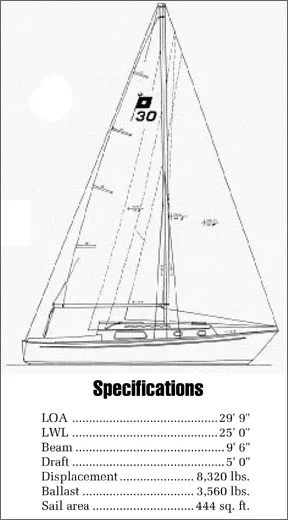
The bow cleat is located well forward and is adequate for the size of lines likely to be used on the boat. However, we would prefer two bow cleats, nearly side by side, in the same location. This is particularly useful in boats which spend a major amount of their lives tied to a dock, as the rule of thumb is that the dockline which needs adjusting is always the bottom line on any cleat.
The vinyl rubrail around the hull-to-deck joint presents a problem when anchoring the Pearson 30. It will undoubtedly be chafed by the anchor line. Redesign or relocation of the bow chocks would be necessary to correct this potential chafe problem.
The large starboard cockpit locker is designated as the boat’s sail locker. We recommend that the locker be put to its intended use. The locker is so deep that small items would end up in a heap in the bottom almost out of reach if they were stored here. Space in the lazarette locker—a natural place for fenders, docklines, and sheets—is limited by the engine exhaust hose. Rerouting this hose would increase the usefulness of this space.
The large cockpit seats four adults comfortably for daysailing and six if they are active enough to stay out of the way of the tiller and the mainsheet. The 4′ long tiller definitely encroaches on the cockpit living space. We would normally be reluctant to recommend wheel steering for a high-performance 30-footer: it would, however, increase cockpit space and might reduce the idiosyncrasies created by the spade rudder when handling the boat under power.
The Pearson 30 has a light, roomy interior for a boat of its size. In the 1980 model, all four ports in the head and forward cabin are of the opening type, greatly improving ventilation, particularly when coupled with the optional, but recommended foredeck-mounted cowl ventilator.
The overhead hatch in the forward cabin is basically a ventilation hatch and is too small for either sails or emergency exit. Anchor storage is awkward without a foredeck anchor well, a welcome addition to many more recently designed boats the size of the Pearson 30.
The 22-gallon water tank and the standard holding tank occupy much of the space under the forward double berth. This double berth is actually the entire forward cabin, and can be closed off from the full width head by double doors. The standard marine toilet is equipped with a proper vented loop. The head wash basin is tucked under the deck and is difficult to use for anyone with less agility than a contortionist. The location of this wash basin is the only serious flaw in the otherwise functional head compartment.
The P30’s main cabin is large and comfortable, with capacious storage above, behind, and below the settees. Owners may find these storage spaces more useful if they are subdivided by partitions to prevent gear stored in one locker from ending up in another.
The under-settee and under-galley lockers cannot be considered dry storage unless the bilge is kept bone dry. Although the lockers are sealed to the bilge at the bottom, owners report that, with their boat heeled, bilge water finds its way into the lockers by running up the inside of the hull behind locker partitions, then down into storage spaces. Most dinghy-hulled boats lack real bilge space or a sump, and as little as a gallon of water in a boat of this type can be annoying.
It is unfortunate that a large number of berths has become a criterion for livability in modern boats. In the past, a 40-footer was likely to have four or five berths. Now six berths are standard on a 30-footer, including the Pearson 30, seven on a 35-footer, and eight on a 40-footer.
Cruising longer than overnight with six on a boat the size of the Pearson 30 is a sure way to terminate friendships and wreck marriages. No responding Pearson 30 owner reported cruising with more than four people on a regular basis.
The standard fold-down cabin table is a practical solution on a boat of this size. The optional slide-out chart table limits room over the quarterberth and lacks the fiddles which are necessary because of its slanted surface.
The Pearson 30 galley is typical of 30-footers. As much as possible is jammed into a necessarily small space. The deep lockers behind the stove and icebox will probably be partitioned into several smaller compartments by the moderately handy owner. Annoyingly, a short person has a hard time reaching the depths of the icebox, particularly if the stove is in use.
We cannot recommend the self-contained alcohol stoves almost always installed on the Pearson 30 and other boats of this size. There is a very real and well-documented risk of explosion if the stove must be refueled while hot. It is the fault of the marine stove industry—and an uninformed consuming public— that these potentially dangerous stoves are still used on many boats.
The galley sink and spigot partially block the companionway. The top companionway step is actually the lid of a nifty storage box, handy for winch handles, spare blocks, and tools.
Engine access is via the companionway steps, which lift out to expose the front of the engine. Two slatted doors in the quarterberth provide additional if awkward access to the engine and fuel tank under the cockpit. There is no soundproofing in the engine compartment.
The new, smaller diesel engine is more accessible for service than the old Atomic Four. It has molded fiberglass engine beds and drip pan, an excellent idea, although some engine vibration is transferred to the hull despite the flexible engine mounts and shaft coupling.
It is rare for a 30-footer to have good engine access. The Pearson 30 is no better than average in this respect.
Despite the above shortcomings, the P30 is highly livable. The advertised 6′ 1″ headroom is really an honest 5 11″ in the main cabin. Achieving good headroom in a 30-footer without serious compromises in appearance is nearly impossible. The Pearson 30 comes as close to achieving this as any boat we have seen in its class.
Conclusions
The Pearson 30 was an industry success story. The boat is fast and responsive. Finish quality is above average. The interior is comfortable and reasonably roomy within the limitations inherent in a 30-footer. Many of the minor design problems can be corrected by the imaginative and handy owner who enjoys tinkering.
Pearson has a reputation for building solid, middle-of-the-road boats: a deserved reputation well in evidence in the P30. The Pearson 30 would be an excellent choice of boat for the aggressive and self-confident beginning sailor who desires high performance for daysailing or club-level racing as well as for reasonably comfortable short-term cruising. It is not the boat for the timid sailor, male or female. The family with two children will find it a comfortable cruiser. Sailors with friends who enjoy spirited sailing and who don’t mind frequent sail changes will also find it a good choice for daysailing and local racing.
The long production run and continued popularity have created a boat with few inherent major problems and high resale value. The Pearson 30 is a good investment.
RELATED ARTICLES MORE FROM AUTHOR
Leave a reply cancel reply.
Log in to leave a comment
Latest Videos

Safety At Sea For You & Your Family – The Joe...

What’s The Best Vinyl Window Cleaner for Your Boat?

40-Footer Boat Tours – With Some Big Surprises! | Boat Tour

Electrical Do’s and Don’ts
- Privacy Policy
- Do Not Sell My Personal Information
- Online Account Activation
- Privacy Manager

Pearson Yachts Portal
Pearson sailboat table.

Table of All Models by Pearson Yachts
All sailboat models.
Listed by model name - click header field to sort by column.
Key to Sailboat Table
- Model: Pearson model name and link to line drawing.
- Type: Boat and Rig Attributes. All types are Bermuda rigged sloop, single mast with fore-and-aft sails, unless otherwise specified by Cat, Ketch, or Yawl.
- LOA: Length Over All, the maximum length of the hull, in feet, from stem to stern measuring parallel to the waterline. This does not include projections of pulpits or spars.
- Draft: Deepest extent of hull, typically bottom distance from waterline to bottom of keel.
- DISP: Displacement, the vessel's weight in pounds, calculated from the volume of water displaced by it.
- SA/D: The sail area to displacement ratio is a bench-mark to evaluate light air performance as well as heavy air conditions.
- Production: Approximate years and number produced.
- Designer: Yacht designer
- Links: Web-Page references. External sites open in new tab or window.
Specifications are approximate from Pearson Yachts.
Key to Designers
- Shaw – William H. Shaw joined Pearson Yachts in 1964 as Chief Architect, eventually running the entire Pearson Yachts Division of Grumman. During his tenure, he and his team designed over 50 different sail and power boats. Bill Shaw
- Alberg – Carl Alberg's successful career as a designer can be linked back to his partnership with Pearson Yachts and early fiberglass yacht construction. Carl Alberg
- Tripp – During the 1960s, William H. Tripp Jr. was one of America’s most successful yacht designers. Bill Tripp
- Rhodes – Philip L. Rhodes was a naval architect known for his diverse yacht designs. Philip Rhodes | Philip Rhodes Vanguard
- Tritt – Bill Tritt is a yacht builder with a keen interest in fiberglass as a material to use in boats and cars. Bill Tritt
- Alden – John G. Alden was an American naval architect and the founder of Alden Designs. John Alden
Fast Boats in Their Time
Click to enlarge
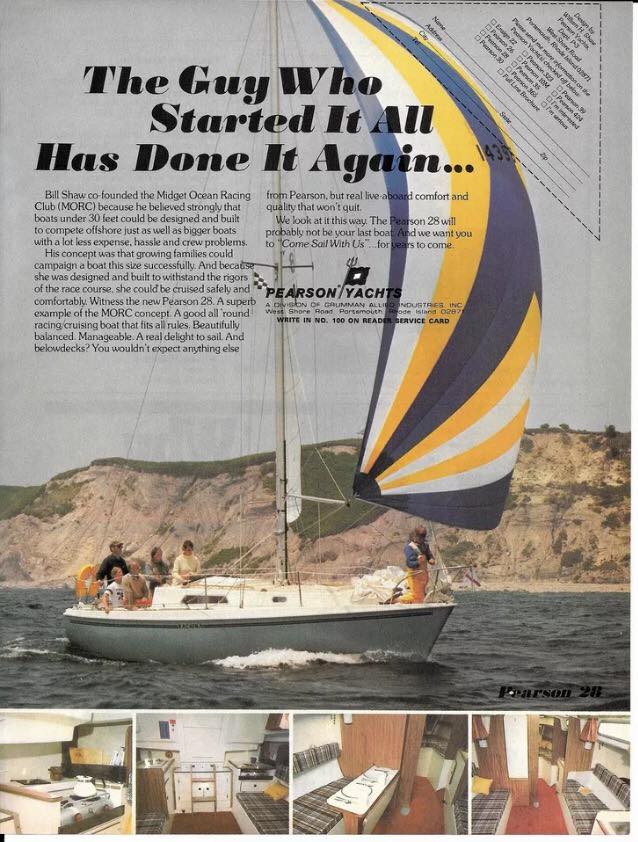
The guy who started it all has done it again...
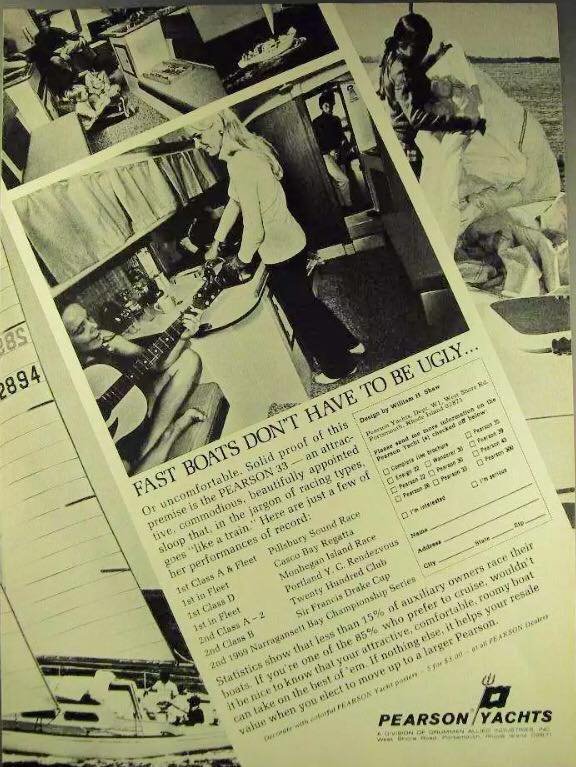
Fast boats don't have to be ugly...


- Forums New posts Unanswered threads Register Top Posts Email
- What's new New posts New Posts (legacy) Latest activity New media
- Media New media New comments
- Boat Info Downloads Weekly Quiz Topic FAQ 10000boatnames.com
- Classifieds Sell Your Boat Used Gear for Sale
- Parts General Marine Parts Hunter Beneteau Catalina MacGregor Oday
- Help Terms of Use Monday Mail Subscribe Monday Mail Unsubscribe
Pearson 303 mast length?
- Thread starter STXCUTTTER
- Start date Jul 18, 2020
- Tags mast and standing rigging pearson 303
- Brand-Specific Forums
Good day all I'm hoping someone can answer this question for me.. I'm tasked with sleeving a 303 mast for a friend and need to know the complete length from mast step (keel stepped) to mast head? It broke at deck level and the base has substantial corrosion. The break is now sleeved but still need numbers to finish the base. Any help would be greatly appreciated. Cheers
Here is the listed data. You can get a good idea but likely will need to measure some of the boat. https://sailboatdata.com/sailboat/pearson-303 Press the help icon for explanation of the sail length measured points. ie. P length.
jssailem said: Here is the listed data. You can get a good idea but likely will need to measure some of the boat. https://sailboatdata.com/sailboat/pearson-303 Press the help icon for explanation of the sail length measured points. ie. P length. Click to expand
In the event a Pearson 303 owner does not have their mast down to measure it's length, 2 suggestions come to mind: 1. Contact these guys who are familiar with the mast length for that boat: Isomat NG46 Mast 2. Climb the mast and drop a tape measure from the mast head to the deck then from the deck to the keel.
sail sfbay said: In the event a Pearson 303 owner does not have their mast down to measure it's length, 2 suggestions come to mind: 1. Contact these guys who are familiar with the mast length for that boat: Isomat NG46 Mast Already tried this to no avail. 2. Climb the mast and drop a tape measure from the mast head to the deck then from the deck to the keel. Click to expand
- This site uses cookies to help personalise content, tailor your experience and to keep you logged in if you register. By continuing to use this site, you are consenting to our use of cookies. Accept Learn more…

Things to do in Moscow: how to visit Moscow | Unmissable, cool & unusual
- September 2, 2023

What are the best things to do in Moscow? What to do in Moscow? First, I will list the main places to visit by theme, passing by the must-sees, but also more unusual places in Moscow. Then, I will describe what to see in Moscow in one day and how to visit Moscow in 2, 3, 4, 5 or 6 days. Let’s go!
Good to know. For more information, click on the places to open the dedicated blog posts.
Main places to visit in Moscow & best things to do in Moscow
I worked in Moscow and I loved this city for its dynamism and energy. We find there from time to time to see friends, remember good memories and enjoy this giant city! Then the time has come for us to share with you our practical guide.
TOP 5 must-see places in Moscow
- Moscow Red Square
- St. Basil’s Cathedral
- Cathedral of Christ the Savior
- Bolshoi Theatre
Places of cultural, historical and religious interest in Moscow
- Novodevichy Convent and cemetery
- Tretyakov Gallery
- Pushkin Museum of Fine Arts
- Kremlin Izmaïlovo (pseudo-historic place, recently built in the image of the old, one of the best things to do in Moscow for your Instagram account 😉 )
- Park and ancient village of Kolomenskoye
Visit Moscow of the Soviet era
- Moscow State University and Sparrows Hill
- VDNKh and the Museum of Astronautics, one of the key landmarks of the Soviet era in Moscow
- GULAG Museum
- Metro stations
- The Stalinist skyscrapers, scattered all over the city
Less touristy places in Moscow
- Gorky Park and the GARAGE museum
- The old Krasny Oktyabr factory
- Zaryadye Park
- Center for Contemporary Art, WINZAVOD
- Business center, Moscow City
Main districts of Moscow to visit
- Patriarch Ponds
- Tchistye Prudy
- Kuznetsky most
- Arbat Street
However, regardless of the length of your stay, whether you are going to visit Moscow in 4 days or in 2, you need a visa. The article Obtaining a tourist visa for Russia could then be useful in any case.
What to do and see in Moscow in one day?
List of things to see and do in Moscow in one day:
- Go to Red Square
- Visit St. Basil’s Cathedral
- See Kremlin walls (but not to visit)
- Visit Cathedral of Christ the Savior
- Discover Kuznetsky most districts and see Bolshoi Theatre building
- And if you have time at the end of the day: go to the Sparrows Hill or to the Moscow City for a beautiful view
Things to do in Moscow in 2 days
If you want to visit Moscow in 2 days, there are 2 purposes: do not miss the essential places of Moscow and optimize travel.
- First day: Red Square , Saint Basil’s Cathedral , Zariadye Park, Bolshoi Theatre , Kremlin
- Day 2: Cathedral of Christ the Savior, the former Krasny Oktyabr factory on Balchug Island, Gorky Park, Moscow State University (one of the Seven Sisters buildings ) and Sparrow Hill
As 2 days os really short, be sure to choose an accommodation in the best districts where to stay in Moscow .
Walking on Red Square in Moscow: one of the unmissable things to do in Moscow
Iconic place and one of the must-see places in Moscow and even in Russia! Besides, if there was only one place to visit in Moscow in 2 days, this place would then be Red Square, without hesitation. Therefore, starting the city tour with Red Square is ideal . Several buildings are on the square, but not all of them have to be visited. Check out my blog post about Moscow’s Red Square in detail to learn more and not miss anything.

Visiting Saint-Basil’s Cathedral inside
Even more emblematic than Moscow’s Red Square! Built in the middle of the 16th century under the orders of Tsar Ivan Le Terrible, this cathedral is one of the most beautiful monuments of Orthodox art, and definitely one of the unmissable places in Moscow. Visiting Saint-Basil’s Cathedral inside is one of the most beautiful things to do in Moscow!
- Visit estimate time : 1h30
- Entry ticket : 700 RUB. Tickets can be purchased on the cathedral’s official website 45 days before the tour.
- Audio guide (recommended): 500 RUB
- Opening hours : June to August 10 am-6pm; from November to April: 11 am-5pm; May, September, October 11 am-5pm. Cathedral closed on Wednesdays. Entrance is closed 45 minutes before closing.
- Find out more in the dedicated article: Saint Basil’s Cathedral in Moscow

Take a walk in Zariadye park: one of the coolest things to do in Moscow after visiting Red Square
Zaryadie Park is just a 10-minute walk from St. Basil’s Cathedral, so it’s easy to include in your itinerary if you’re going to visit Moscow in 2 days. From its heights, you can see the red walls of the Kremlin. But, the most impressive point of view is the platform which overlooks the Moskva river. A must see! And clearly one of the coolest things to do in Moscow!
- Open 24 hours a day
- Good to know! Park Zaryadye is also a place to visit in Moscow in winter. Find out more here: What to do in Moscow in winter?

See the Bolshoi Theatre and discover the Kuznetsky Most district
The Bolshoi Theatre is the most famous Russian theater in the world. The most economical way to see a presentation at the Bolshoi Theater is to take the tickets on the theater’s official website in advance, so here is our tutorial to help you: How to buy entrance tickets to the Bolshoi? In addition, several pedestrian or one-way streets
The Bolshoi Theater is the most famous Russian theater in the world. The most economical way to see a presentation at the Bolshoi Theater is to take the tickets on the theater’s official website in advance, so here is our tutorial to help you: How to buy tickets to the Bolshoi? In addition, several pedestrian or one-way streets are located north of the theater. It is therefore very pleasant to find them to leave the main axes of the megalopolis.

Visit the Moscow Kremlin
Visit Kremlin is on top of things to do in Moscow. A place of power for centuries, the Kremlin then shows us a whole different image when viewed from the inside. If you want to visit Moscow in 2 days, the Kremlin is certainly one of the must-see places in Moscow.
- Opening hours : Daily from 10 a.m. to 5 p.m., except Thursday.
- See our blog post about visiting the Moscow Kremlin

Visit the Cathedral of Christ the Savior
This impressive Moscow Cathedral is the seat of the Russian Orthodox Church. It is a must see if you visit Moscow in 2 days and clearly one of the things to do in Moscow. The Cathedral of Christ the Savior was first built in 1883 in memory of Russia’s victory over Napoleon’s Grand Army. Then in 1931 Stalin ordered its destruction. It was then rebuilt again (identically) only in 2000.
- Where? Ulitsa Volkhonka 15. At the foot of the Kropotkinskaya metro station.
- Opening hours . Daily: 10: 00-17: 00, except Monday: 13: 00-17: 00
- Free entry (some closing restrictions, for example a short)
Good to know! In orthodox religious places, one must avoid excessively uncovered clothing. Women should cover their heads. After visiting the Cathedral of Christ the Savior, you can explore Bolotny Island and Gorky Park. This is one of the routes our guide to Moscow.

The old Krasny Oktyabr factory: one of the coolest things to do in Moscow
If you cross the Moskva River by a pedestrian bridge which is located just in front of the Cathedral of Christ the Savior, you will enjoy a beautiful view of the city and at the same time you can discover Balchug Island. Furthermore, if you want to visit Moscow in 2 days, you can include this island in your itinerary between the cathedral and Gorky park. Here is the old confectionery factory Krasny Oktyabr, which has gradually turned into a fashionable micro-district. There are then some elements of street art, cafes and restaurants and some Moscow bohemian side. At the end of the island you can see a gigantic 98-meter-high monument dedicated to the Russian reforming tsar Pierre The Great.
Good to know! You can find on this island are the trendiest nightclubs in Moscow. On weekends, there are taxi caps after midnight so there are so many people. On the other hand, if you go there in winter and during the day, the island is quite empty and less interesting to see.
Gorky Park is one of the TOP places to visit in Moscow, because it allows you to better understand the life of the locals and their rhythm. In fact, it’s a huge entertainment park. For example, in winter there is a giant ice rink and in summer – free dance or yoga lessons, sandy beaches for playing volleyball, an outdoor cinema. So, like the locals, have a Stakantchik (ice cream or cooked corn), and enjoy the atmosphere of the place: that’s one of the interesting things to do in Moscow to discover the city.
- Where? Krymsky Val 9. 20 minutes’ walk from Krasny Oktyabr, along the quays.
Sparrow Hill and Moscow State University
The Sparrow Hill, Vorobiovy Gori in Russian, is the highest point in Moscow. It is rather known to Russians, but less to travelers. A nice view on Moscow opens from the hill, and in particular on the Luzhniki Stadium. In addition, on the hill itself is the Moscow State University: an impressive skyscraper from the Soviet era.
- How to get there? By bus T7 (35 min) from Oktyaborskaya station, near Gorki Park. By metro (Vorobiovy Gorki station) + climb the hill on foot. On foot along the Moskva along the Gorky Park (1h30) + climb in funiculars.
Good to know! It is possible to cross the Moskva river by funicular. We actually tested it and it was pretty cool! That is one of our favorite things to do in Moscow!

What to do in Moscow in 3 days?
If you are going to visit Moscow in 3 days, it would be interesting to dive into the Soviet era which strongly marked the country and the city. After the Bolshevik Revolution, the capital was transferred from Saint Petersburg to Moscow, in order to mark the change of power. Moscow then became the world showcase for communist ideology. Here are the best things to do in Moscow for 3-day-trip!
VDNKh, visit Moscow of the Soviet era
VDNKh is a large exhibition center in the north of Moscow, where there are still several striking witnesses of the USSR. The most interesting are the Museum of Cosmonauts and the Statue of the Worker and the Kolkhozian , which will certainly impress you with its size!

GULAG History Museum
The explanations of the museum are very well done. We really have the feeling of going back in time. If you are going to visit Moscow in 3 days and you are interested in history and this subject in particular, I recommend this museum. Visit the GULAG History Museum is one of the most interesting things to do in Moscow.

Discover the Patriarche Pounds district
It’s a nice neighborhood in Moscow where you can come across rather affluent locals, but not necessarily very bling-bling. Take a walk in this area is really a cool thing to do in Moscow! In addition, the Ponds of Patriarch is one of the places of Bulgakov’s novel “Master and Margarita”. As this is an interesting area to see, we have included it in a walking tour of Moscow. The route ends at the Moscow Kremlin, which is very convenient, because you will be able to visit Moscow in 3 days by optimizing your trips.

What to visit in Moscow in 4 days: TOP things to do in Moscow in 4 days
If you want to visit Moscow in 3 days, you will already see a lot of things. On the other hand, if you stay one more day, you have plenty to do! The Novodevichy Convent, the Tchistie Proudy district and the Izmaylovo Kremlin are very good candidates for you, if you are going to visit Moscow in 4 days.
Visiting Novodevichy Convent in Moscow
The Novodevichy Convent is one of the most brilliant examples of Russian architecture, according to UNESCO. This beautiful complex was built in 1524 and today consists of the convent, but also of a cemetery whose status could be compared to that of Père-Lachaise in Paris. Visiting Novodevichy Convent is one of the great things to do in Moscow, if you want to go a little bit outside of the center!

Discovering Tchistye Proudy district
It’s one of the most popular areas of Moscow, with many cafes, restaurants and bars nearby. It is therefore a place to discover if you want to visit Moscow in 4 days. It is just as pleasant for a stroll as for the discovery of local life. For example, in winter the pond turns into an ice rink.
Visiting the Izmaylovo Kremlin, one of the coolest things to do in Moscow!
The Izmaylovo Kremlin is more of a tourist than a historic place. On the other hand, it is a pretty impressive place to discover, especially on weekends. Inside the Kremlin, there is a flea market where you can find a little bit of everything, but mostly good souvenirs to bring from Moscow. For example, chapka, traditional Russian scarves or matryoshka (Russian dolls). Add the Kremlin and the Izmaïlovo market to your itinerary if you are going to visit Moscow in 4 days, because it is a nice and very colorful place! Visiting the Izmailovo Kremlin is one of the things to do in Moscow, if you want to put colors in your Instagram account! 😉

In 4 days, we will have the opportunity to see several Moscow: Classic Moscow, Moscow of old Russia, Soviet Moscow and a little bit of the new Moscow. So what to visit in Moscow on the 5th day of travel?
What to visit in Moscow in 5 days?
Art lovers will be delighted to discover the Tretyakov Gallery and the Pushkin Museum of Fine Arts, while others will prefer to stroll along Arbat Street, see the buildings of Moskva-City or visit Bunker 42.
Admiring Russian art at Tretyakov Gallery
Founded in 1856 by an industrialist and great lover of art, the gallery has grown over the decades, and then bequeathed to the state. Today the collection includes more than 140,000 pieces, 15,000 of which are paintings. Visiting the Tretyakov Gallery is one of the things to do in Moscow if you want to discover Russian art!
- Where? Pereoulok Lavrouchinski 10. A 5-minute walk from Tretiakovskaya station
- Opening hours. Open from 10 a.m. to 6 p.m. until 9 p.m. Thursday and Friday. Closed on Mondays.
- Entry tickets. 500 RUB.

Visiting the Pushkin Museum of Fine Arts
The Pushkin Museum of Fine Arts presents the treasures of ancient Egypt, the paintings of Rembrandt and Cézanne, a fine collection of Impressionism.
- Where? Ulitsa Volkhonka 12
- Opening hours. Daily: 10: 00-20: 00, except Thursday: 11: 00-21: 00. Closed on Mondays. The boxes close an hour before closing.
- Entry tickets. The prices vary according to the collections from 300 to 750 RUB.
Walking on Arbat Street
All Russians know Rue Arbat. So, walking on Arbat street is one of the things to do in Moscow. However, after the years, little by little it became very touristy. This is a pedestrian street only. There are souvenir shops, restaurants and cafes there, but it is no longer the most authentic neighborhood in the city.

Seeing the buildings of Moskva-City (Moscow City)
Moskva-City is Moscow’s business center, much like Paris’s Defense district. The skyscrapers of Moskva-City are among the tallest in Europe: 373 meters high! Very nice place to see at dusk.
Good to know! You can admire a nice view of Moscow City from the docks of Tarasa Shevchenko. It’s especially beautiful in the evening with all the lights on.
Bunker 42, one of the most unusual things to do in Moscow
Bunker 42 is a secret military complex which was to be used by the Soviets in the event of a nuclear attack: a space of 7000 m² 65 meters underground!
- Where? 5 Kotelnitcheski Lane, 11.
- Prices. 2200 RUB per person
- Opening hours. Open daily from 10 a.m. to 8 p.m.
- Restaurant inside. Original, but rather a tourist trap.
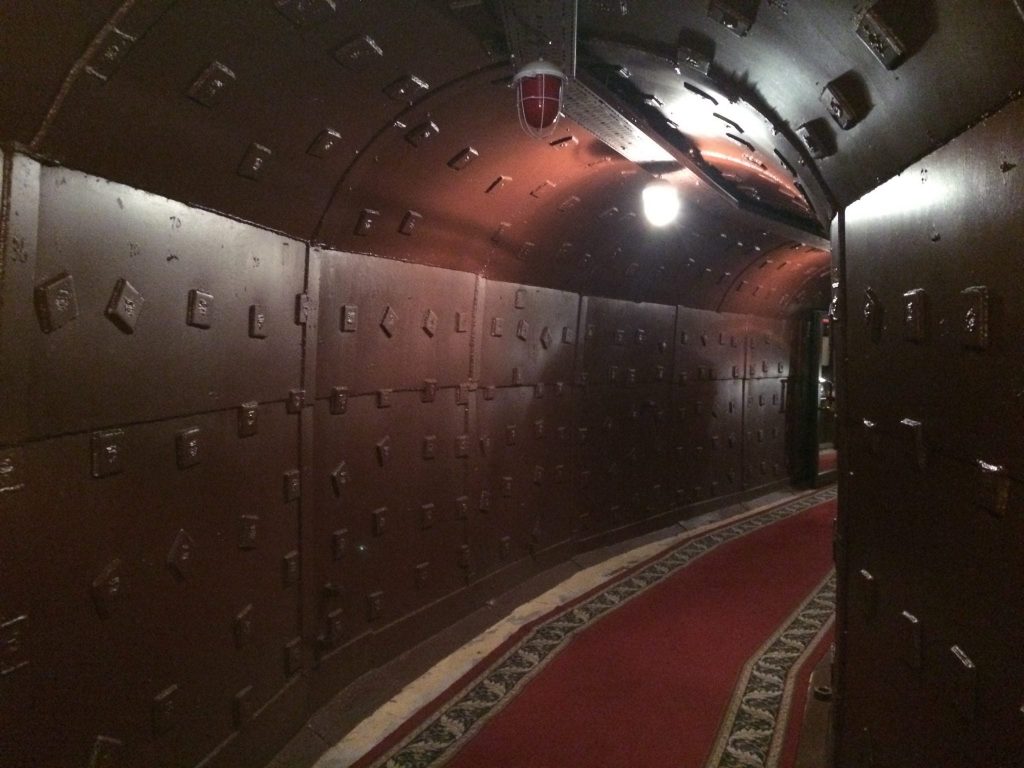
What to visit in Moscow in 6 days or more?
There are still so many places to see, because Moscow is a big megalopolis and there is always something exciting to do there. For example: the ancient Kolomenskoye village or the WINZAVOD contemporary art center .
If you are interested in history and want to see Russian cities on a rather “human scale”, it would certainly be interesting for you to discover the cities of the Golden Ring . For example, it is very easy to get to Sergey Posad from Moscow (less than 2 hours in train). Visiting the Golden Ring is one of the best things to do in Moscow if you are staying more than a 5-6 days.
There are still plenty of places to see in Moscow, however I did my best to list here the best things to do in Moscow, what to see in Moscow in one day, but also in 2, 3, 4 or 5 days in Moscow!
Moscow travel tips:
- Airport transfer: how to go to Moscow?
- Where to stay in Moscow (hotels, districts)?
- Tourist voucher for Russian visa
- Christmas and New Year in Moscow
- What is the best time to visit Moscow?
Leave a Reply Cancel reply
Your email address will not be published. Required fields are marked *
Save my name, email, and website in this browser for the next time I comment.
Novodevichy Convent and cemetery in Moscow: tickets, cemetery map
Hermitage museum in saint petersburg: tickets, best time to visit, you may also like.

When is the best time to visit Moscow? | Weather, budget, events by month
- July 14, 2023

Seven Sisters Moscow | Where to find the soviet skyscrapers in Moscow?
- December 27, 2023

Moscow in winter | What to do in Moscow in winter? How to dress?
- October 1, 2023

Saint Basil’s Cathedral in Moscow | Tickets & things to visit inside
- March 7, 2024

Where to stay in Moscow: best districts & hotels in Moscow, what to avoid
- February 13, 2024

Christmas and New Year in Moscow: best markets and decorations to see
- September 18, 2023
2018 Primetime Emmy & James Beard Award Winner
R&K Insider
Join our newsletter to get exclusives on where our correspondents travel, what they eat, where they stay. Free to sign up.
A History of Moscow in 13 Dishes
Featured city guides.

IMAGES
VIDEO
COMMENTS
An updated version introduced in 1984 moved the traveler to the cabin trunk and added a chart table. Reported displacement increased to 10,400 lbs. Beginning in 1985, the Yanmar 2GM20F, with 16hp, was installed. Earliest hulls had balsa core in their bottom and in the horizontal areas of the deck. At some point, hulls became […]
The Pearson 303, introduced in 1983, is a fairly typical example of the kind of work Pearson was doing in the mid-1980s, continuing until its sale in 1991 to Aqua Buoy, which has yet to resume production. During 1983, Pearson built 12 different models, ranging from the durable 22′ 6″ Ensign to the Pearson 530, the largest boat the company ...
The Pearson 303 : 1983-1986. A boat that we feel fits the real sailing needs of a large number of yachtsmen. Fits The Mold theBoat. ... Pearson 303 Specifications - SailboatData.com; Pearson-Info P303 - dan.pfeiffer.net ; Pearson 303 Brochure. Click to enlarge. Page 1. Page 2.
The author's well-loved Pearson 303 shows off her pretty sheer line and unpretentious good looks. Allison Reeve. By the early 1980s, Pearson Yachts of Portsmouth, Rhode Island, had built more than 1,000 Bill Shaw-designed Pearson 30s. To replace that seemingly timeless design, in 1983 Shaw created the Pearson 303, and it's an entirely ...
The Pearson 303 is a 30.29ft masthead sloop designed by William Shaw and built in fiberglass by Pearson Yachts between 1983 and 1986. ... The data on this page has been derived from different sources but a significant part is attributed to sailboatdata.com. We thank them for their encouragements and friendly collaboration.
Pearson 303 is a 30′ 3″ / 9.2 m monohull sailboat designed by William Shaw and built by Pearson Yachts between 1983 and 1986. Great choice! Your favorites are temporarily saved for this session. ... sailboatdata.com / CC BY. Embed Embed. View Demo.
The Pearson 303 is a recreational keelboat, built predominantly of fiberglass with a balsa core and with wood trim. It has a masthead sloop rig, a raked stem, a vertical transom, a skeg -mounted rudder controlled by a wheel, with an emergency back-up tiller and a fixed fin keel. It displaces 10,100 lb (4,581 kg) and carries 3,500 lb (1,588 kg ...
The Pearson 303 is a recreational keelboat, built predominantly of fiberglass with a balsa core and with wood trim. It has a masthead sloop rig, a raked stem, a vertical transom, a skeg-mounted rudder controlled by a wheel, with an emergency back-up tiller and a fixed fin keel. It displaces 10,100 lb (4,581 kg) and carries 3,500 lb (1,588 kg ...
Our goal is to preserve and enhance information for those sailing and maintaining classic plastic Pearson boats. The site is regularly updated as new information is discovered. As many boat owners websites come and go on the internet, this site serves as a resilient portal for Pearson boat owners. It features a repository of enhanced original ...
The Pearson 30 has a well-proportioned masthead rig. The mainsail comprises 44% of the working sail area, more than is found on many modern "racercruisers," but a reasonable proportion for a true multi-purpose boat. Base price in 1971 was $11,750. By November 1979, base price had jumped to $28,300.
The Pearson 303 is a 30.29ft masthead sloop designed by William Shaw and built in fiberglass by Pearson Yachts between 1983 and 1986. The Pearson 303 is a moderate weight sailboat which is slightly under powered. It is stable / stiff and has a low righting capability if capsized. It is best suited as a coastal cruiser.
Key to Sailboat Table. Model: Pearson model name and link to line drawing. Type: Boat and Rig Attributes. All types are Bermuda rigged sloop, single mast with fore-and-aft sails, unless otherwise specified by Cat, Ketch, or Yawl. LOA: Length Over All, the maximum length of the hull, in feet, from stem to stern measuring parallel to the waterline.
4,638. Hunter 46 Point Richmond, CA. Jul 19, 2020. #4. In the event a Pearson 303 owner does not have their mast down to measure it's length, 2 suggestions come to mind: 1. Contact these guys who are familiar with the mast length for that boat: Isomat NG46 Mast. 2. Climb the mast and drop a tape measure from the mast head to the deck then from ...
44' McCurdy and Rhodes designed Tillotson Pearson Yachts Navy 44 Annapolis Maryland, Maryland Asking $37,000. 26' macgregor 26x Huntington Station, New York Asking $19,000. 37.6' CT CT-38 Warwick Alameda, California Asking $49,995. 25.8' Colgate 26 Norwalk, Connecticut Asking $49,000. 43' Catalina Morgan 43
Embark on a captivating journey through the heart of Moscow with our immersive City Walk. ⚠️ Follow for more: https://www.youtube.com/@Real-Russia-4K-Walks F...
Things to do in Moscow in 2 days. If you want to visit Moscow in 2 days, there are 2 purposes: do not miss the essential places of Moscow and optimize travel. First day: Red Square, Saint Basil's Cathedral, Zariadye Park, Bolshoi Theatre, Kremlin. Day 2: Cathedral of Christ the Savior, the former Krasny Oktyabr factory on Balchug Island ...
CNN —. Russia has been left reeling in the wake of the nation's worst terrorist attack in decades. ISIS has claimed responsibility for the massacre, which saw armed assailants storm a popular ...
1: Off-kilter genius at Delicatessen: Brain pâté with kefir butter and young radishes served mezze-style, and the caviar and tartare pizza. Head for Food City. You might think that calling Food City (Фуд Сити), an agriculture depot on the outskirts of Moscow, a "city" would be some kind of hyperbole. It is not.